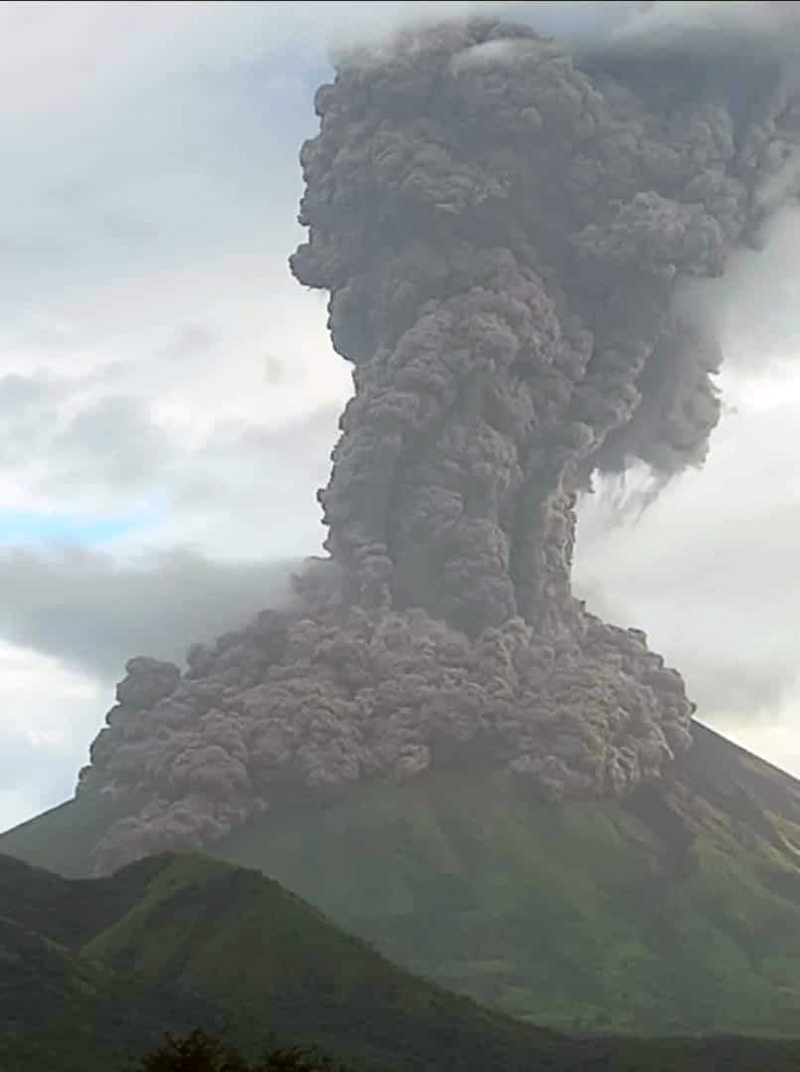Report on San Cristobal (Nicaragua) — August 2023
Bulletin of the Global Volcanism Network, vol. 48, no. 8 (August 2023)
Managing Editor: Benjamin Andrews.
Edited by Kadie L. Bennis.
San Cristobal (Nicaragua) Strong explosion with an ash plume, pyroclastic flows, and ashfall on 5 July 2023
Please cite this report as:
Global Volcanism Program, 2023. Report on San Cristobal (Nicaragua) (Bennis, K.L., and Andrews, B., eds.). Bulletin of the Global Volcanism Network, 48:8. Smithsonian Institution.
San Cristobal
Nicaragua
12.702°N, 87.004°W; summit elev. 1745 m
All times are local (unless otherwise noted)
San Cristóbal (also known as El Viejo), is located in Nicaragua and consists of five principal volcanic edifices that form the NW end of the Marrabios Range. Recorded eruptions date back to 1528, with more frequent eruptions occurring over the last 50 years. The most recent eruption period began in December 2020 and was characterized by small ash explosions and gas-and-steam emissions (BGVN 47:09). This report describes a short, one-day eruption on 5 July 2023, according to the Instituto Nicaragüense de Estudios Territoriales (INETER) and Sistema Nacional para la Prevención, Mitigación y Atención de Desastres (SINAPRED).
Activity during September 2022 through June 2023 was low, according to INETER; gas-and steam emissions and seismicity were still sometimes registered. Monitoring data reported by INETER consistently included the average sulfur dioxide levels (tons/day) and the total number of earthquakes per month, a small number of which were volcano-tectonic (VT) events (table 10). Tremor generally remained within 60-160 RSAM (Real-Time Seismic Amplitude Measurements); during June RSAM units were 60-1,200 and during 26 June through 5 July they were 200-400.
Table 10. Monthly sulfur dioxide measurements and seismicity reported at San Cristóbal during September 2022 through July 2023. Courtesy of INETER.
| Month | Average SO2 | Total earthquakes | Volcano-tectonic (VT) earthquakes |
| Sep 2022 | 334 t/d | -- | -- |
| Oct 2022 | 310 t/d | 4,260 | 260 |
| Nov 2022 | 432 t/d | 2,931 | 0 |
| Dec 2022 | -- | -- | -- |
| Jan 2023 | -- | -- | -- |
| Feb 2023 | -- | -- | 0 |
| Mar 2023 | 89 t/d | 6,319 | 0 |
| Apr 2023 | 63 t/d | 5,831 | 0 |
| May 2023 | 342 t/d | 6,978 | 0 |
| Jun 2023 | 479 t/d | 40,185 | 0 |
| Jul 2023 | 1,281 t/d | 17,964 | 0 |
Approximately 40,185 seismic events were recorded during June, with the RSAM units fluctuating between 60 up to 1,200. On 4 June, tremor increased and remained elevated until 8 June. Tremor declined to background levels until 21 June, when another increase was noted and remained elevated for several weeks.
During July the number of earthquakes decreased compared to June, with 17,964 registered. On 5 July at 1705 an explosion was reported that lasted a few minutes. A gas-and-ash plume rose 2 km above the crater and drifted SW and W (figure 47). Ashfall was reported in Las Grecías (12 km WSW), La Bolsa, and other smaller surrounding communities, according to data corroborated by the Risk Management unit of the Mayor’s Office of Chinandega. Pyroclastic flows were reported at the summit traveling 1 km, based on an analysis of Sentinel-3 images. The sulfur dioxide emissions rose as high as 1,281 t/d on 12 July, based on measurements using the Mobile DOAS technique. The eruption damaged crops and burned plants and grass in the area surrounding the volcano (figure 48). According to a Sentinel image captured on 9 July a narrow, dark deposit extended about 10 km W from the summit crater.
Thermal activity was relatively low since June 2022; according to the MIROVA (Middle InfraRed Observation of Volcanic Activity) graph, four thermal anomalies were detected during March through June 2023 (figure 49). Infrared satellite images showed occasional small hotspots in the summit crater during April through July 2023 (figure 50).
Geological Summary. The San Cristóbal volcanic complex, consisting of five principal volcanic edifices, forms the NW end of the Marrabios Range. The symmetrical 1745-m-high youngest cone, named San Cristóbal (also known as El Viejo), is Nicaragua's highest volcano and is capped by a 500 x 600 m wide crater. El Chonco, with several flank lava domes, is located 4 km W of San Cristóbal; it and the eroded Moyotepe volcano, 4 km NE of San Cristóbal, are of Pleistocene age. Volcán Casita, containing an elongated summit crater, lies immediately east of San Cristóbal and was the site of a catastrophic landslide and lahar in 1998. The Plio-Pleistocene La Pelona caldera is located at the eastern end of the complex. Historical eruptions from San Cristóbal, consisting of small-to-moderate explosive activity, have been reported since the 16th century. Some other 16th-century eruptions attributed to Casita volcano are uncertain and may pertain to other Marrabios Range volcanoes.
Information Contacts: Instituto Nicaragüense de Estudios Territoriales (INETER), Apartado Postal 2110, Managua, Nicaragua (URL: http://www.ineter.gob.ni/); Sistema Nacional para la Prevencion, Mitigacion y Atencion de Desastres (SINAPRED), Edificio SINAPRED, Rotonda Comandante Hugo Chávez 50 metros al Norte, frente a la Avenida Bolívar, Managua, Nicaragua (URL: http://www.sinapred.gob.ni/); MIROVA (Middle InfraRed Observation of Volcanic Activity), a collaborative project between the Universities of Turin and Florence (Italy) supported by the Centre for Volcanic Risk of the Italian Civil Protection Department (URL: http://www.mirovaweb.it/); Copernicus Browser, Copernicus Data Space Ecosystem, European Space Agency (URL: https://dataspace.copernicus.eu/browser/).





